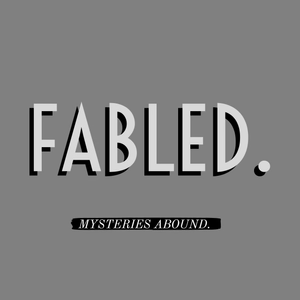
4-The Myths We Make: Part One
05/29/18 • 7 min
Thank you for listening and remember, Mysteries Abound.
Find us at:
Twitter: @FabledPod
Instagram: @fabledpod
#fabledpod #mysteriesabound
Join the conversation at our Facebook group: https://www.facebook.com/groups/fabledpod
Humans love to make monsters. From Count Dracula to Jigsaw, we can’t help but give the creatures living in the dark corners of our minds some semblance of life. Whether that life is on paper and housed in the imaginations of the reader or seen on the big screen at your local cinema, we delight in frightening each other with the horrors we create and, at the end of our experiences with them, we take a breath and tell ourselves “That was fun but at least it wasn’t real.” And that’s true... right? What if the monsters that dwell in our imagination have the potential to be just that: real? Is it possible we can create our worst fears by focusing so intensely on them that they spring into existence, fully formed and ready to rain terror on us? Some think so, and this focus on our fears may have created the worst monster of all: Today, we discuss Slender Man.
To get to where we need to go with this idea of what Slender Man may be, we need to travel back in time to the origins of Tibetan Buddhism and explore the idea of the Thought-Form, or Tulpa, which is also referred to as an Emanation in ancient scripts. Going back to the earliest days of Buddhism there have always been teachings that deal with the concept of time, reality, and what we really are as sentient creatures. These teachings on the nature of reality led some of the practitioners of Buddhism to develop the concept of the Emanation. An Emanation, or Tulpa, was an extension of oneself on a spiritual level, however, powerful Buddha were said to have been able to create individual Tulpas that could think and act outside the will of their creator. This ability to create an Emanation was an explanation in early Buddhism as to how some of the Buddha throughout history were able to travel to heavenly realms while their body remained here in this realm. The practitioners would meditate in such a focused way that they would literally create a projection or copy of themselves in the heavenly realm they wished to visit. Obviously the idea of the Tulpa is a deeply spiritual one to practitioners of different sects of Buddhism and is vastly different in practice to the Thought-Forms we will discuss shortly. However, for our purposes, it is important to note that people have been claiming the ability to literally create beings from nothing but thoughts for many centuries.
As with most things, Western culture in the early 20th century took the teachings of the Tibetan monks and adapted the concept of the Emanation into the idea of the Thought-Form and brought it to America. These people, calling themselves Theosophists, or religious philosophers, were led by a woman named Helena Blavatsky and drew upon what she referred to as ancient knowledge from “The Masters”, or, ancient spirits whom she claimed to have a psychic or spiritual connection with. Theosophists believed that if groups of people focused their thoughts on a particular idea for long enough, it would manifest physically in our world. Another group who took the concept of the Tulpa and ran with it was The Hermetic Order of the Golden Dawn. This group rose to some popularity in the late 19th and early 20th centuries and included notable people such as Alistair Crowley, the famed magician, author, and occult leader, among its ranks and leadership. The HOGD was a group of like-minded people who focused their studies on such things as the occult, paranormal activity, and metaphysics as a way to understand the world around them and to practice magic that might benefit themselves. Among many things they are known for (mostly large orgies claiming to be for channeling some sort of universal magic) this group practiced a magic with the idea that they could summon some sort of psychic though-form being known to them as the Egregore. The Egregore, according to this group, could be summoned by particularly powerful people or collectively via psychic projection. Much like the following anecdote, this Egregore was also said to be autonomous and independent from its creators, like the Tulpa over time grew to be. Interestingly enough, the Egregore has also been used to explain the way a modern meme can spread and deliver ideas to masses of people simultaneously. As opposed to a physical being manifesting, an idea manifests in our collective conscience from the meme. At the same time the Theosophists and the Golden Dawn were appropriating the Eastern mythology for their own uses, a woman named Alexandra David-Neel (pronounced Nael) was studying Eastern religion in Tibet. Now, she claims to have seen a Tulpa in action while there, and some of her writings claim she even created one for...
Thank you for listening and remember, Mysteries Abound.
Find us at:
Twitter: @FabledPod
Instagram: @fabledpod
#fabledpod #mysteriesabound
Join the conversation at our Facebook group: https://www.facebook.com/groups/fabledpod
Humans love to make monsters. From Count Dracula to Jigsaw, we can’t help but give the creatures living in the dark corners of our minds some semblance of life. Whether that life is on paper and housed in the imaginations of the reader or seen on the big screen at your local cinema, we delight in frightening each other with the horrors we create and, at the end of our experiences with them, we take a breath and tell ourselves “That was fun but at least it wasn’t real.” And that’s true... right? What if the monsters that dwell in our imagination have the potential to be just that: real? Is it possible we can create our worst fears by focusing so intensely on them that they spring into existence, fully formed and ready to rain terror on us? Some think so, and this focus on our fears may have created the worst monster of all: Today, we discuss Slender Man.
To get to where we need to go with this idea of what Slender Man may be, we need to travel back in time to the origins of Tibetan Buddhism and explore the idea of the Thought-Form, or Tulpa, which is also referred to as an Emanation in ancient scripts. Going back to the earliest days of Buddhism there have always been teachings that deal with the concept of time, reality, and what we really are as sentient creatures. These teachings on the nature of reality led some of the practitioners of Buddhism to develop the concept of the Emanation. An Emanation, or Tulpa, was an extension of oneself on a spiritual level, however, powerful Buddha were said to have been able to create individual Tulpas that could think and act outside the will of their creator. This ability to create an Emanation was an explanation in early Buddhism as to how some of the Buddha throughout history were able to travel to heavenly realms while their body remained here in this realm. The practitioners would meditate in such a focused way that they would literally create a projection or copy of themselves in the heavenly realm they wished to visit. Obviously the idea of the Tulpa is a deeply spiritual one to practitioners of different sects of Buddhism and is vastly different in practice to the Thought-Forms we will discuss shortly. However, for our purposes, it is important to note that people have been claiming the ability to literally create beings from nothing but thoughts for many centuries.
As with most things, Western culture in the early 20th century took the teachings of the Tibetan monks and adapted the concept of the Emanation into the idea of the Thought-Form and brought it to America. These people, calling themselves Theosophists, or religious philosophers, were led by a woman named Helena Blavatsky and drew upon what she referred to as ancient knowledge from “The Masters”, or, ancient spirits whom she claimed to have a psychic or spiritual connection with. Theosophists believed that if groups of people focused their thoughts on a particular idea for long enough, it would manifest physically in our world. Another group who took the concept of the Tulpa and ran with it was The Hermetic Order of the Golden Dawn. This group rose to some popularity in the late 19th and early 20th centuries and included notable people such as Alistair Crowley, the famed magician, author, and occult leader, among its ranks and leadership. The HOGD was a group of like-minded people who focused their studies on such things as the occult, paranormal activity, and metaphysics as a way to understand the world around them and to practice magic that might benefit themselves. Among many things they are known for (mostly large orgies claiming to be for channeling some sort of universal magic) this group practiced a magic with the idea that they could summon some sort of psychic though-form being known to them as the Egregore. The Egregore, according to this group, could be summoned by particularly powerful people or collectively via psychic projection. Much like the following anecdote, this Egregore was also said to be autonomous and independent from its creators, like the Tulpa over time grew to be. Interestingly enough, the Egregore has also been used to explain the way a modern meme can spread and deliver ideas to masses of people simultaneously. As opposed to a physical being manifesting, an idea manifests in our collective conscience from the meme. At the same time the Theosophists and the Golden Dawn were appropriating the Eastern mythology for their own uses, a woman named Alexandra David-Neel (pronounced Nael) was studying Eastern religion in Tibet. Now, she claims to have seen a Tulpa in action while there, and some of her writings claim she even created one for...
Previous Episode

3-Home Means Nevada
Humans have a tendency to attribute mystery to the mundane. When mysterious impressions are found in 19th-century Nevada, the question everyone has on their minds is "where did these come from?"
Thank you for listening and remember, Mysteries Abound.
Find us at:
Twitter: @FabledPod
Instagram: @fabledpod
#fabledpod #mysteriesabound
Join the conversation at our Facebook group: https://www.facebook.com/groups/fabledpod
Fabled is a podcast for fans of Unsolved Mysteries, Lore, Slender Man, mysteries, mystery, Pokemon, creepypasta, creepy pasta, horror stories, horror, paranormal, ghosts, legends, myths, and stories.
Next Episode

5-The Myths We Make: Part Two
Thank you for listening and remember, Mysteries Abound.
Find us at:
Twitter: @FabledPod
Instagram: @fabledpod
#fabledpod #mysteriesabound
Join the conversation at our Facebook group: https://www.facebook.com/groups/fabledpod
Transcript:
First off, I want to give a huge shout out to Jim, who goes by @Hellhound911 on Twitter for the kind iTunes review and to reaching out to me @FabledPod on Twitter to let me know he listens. Listeners like him help the production of a show such as this all the more worthwhile. Also thank you to Ryan Simms (@RSimm_01 on Twitter) for listening and for the feedback on the episode lengths. This show started as a passion project of mine and the episodes have been only as long as I could stand to listen to myself talk. The episodes are getting incrementally longer as my comfort level increases so longer episodes should be coming down the pike soon. One last shout out to shnoobles for the great review on iTunes. If you haven’t yet, leave a review on iTunes and share this show with a friend; it’s the best way to keep this thing going and to build a great community of listeners. I’ve started a Facebook group as well and I’ll link it in the description of this episode. Thank you all so much for the support.
Now, on with the show...
Tulpas. Thoughtforms. Egregore. Our last episode covered the basics of what these were and outlined some topics that you may need to have a passing knowledge of for this episode. If you have not done so yet, please go back and listen to part one. It is worth it. We will all be here waiting when you return.
A photo of a group of children exists. In that photo, the seemingly-terrified children look toward the camera in what appears to be abject horror; some appear to be running, some soldiering on toward the cameraman, shoulders slumped and eyes downcast. In the background of this photo there is... something. A blur, or mist in the vague shape of a humanoid. The pale, featureless orb atop its neck where a head should be faces the camera and takes in the children before it. This entity is ushering the children along, but to what end? Who can tell? Below, the photo is captioned:
We didn't want to go, we didn't want to kill them, but its persistent silence and outstretched arms horrified and comforted us at the same time...
[Dated] 1983, photographer unknown, presumed dead.
The Slender Man has arrived.
One day in 2014, 12 year olds Anissa and Morgan lured their friend Peyton into the woods. Once deep enough into the woods that they would not be disturbed or overheard, the two girls attacked Peyton, one holding her down while another stabbed her 19 times. It was a horrible, inexcusable crime and I am deeply sorry to the families of those affected. For our purposes, this is all the detail that needs to be discussed. The case has been documented in detail in many other places. Why would two children do this to a friend? According to the two attackers, this was an attempt to appease the Slender Man, to prove to the world that he was real, and the sacrifice of this little girl was going to be the key to doing just that. But Peyton survived the brutal and senseless assault. Mustering her strength and crawling out of the woods to the nearest road, she flagged down a bicyclist who contacted first responders. Luckily, Peyton made it through the ordeal and lived to assist police in finding her attackers. Anissa and Morgan were so convinced that the Slender Man was real that they were willing to take the life of another child to prove it. They are paying for their crimes, but the fact remains that they attempted to kill for a fictional creature. This is an extreme example concerning the validity of Slender Man’s existence. But many more people have claimed to have seen or even interacted with the creature. Most, like the aforementioned criminal act, can be disregarded as mental instability or overactive imaginations but is every case so easily discounted? Can it be possible that, much like Alexandra David-Neel’s portly monk, we have collectively created a thoughtform that has broken free from its creator? Can an internet myth really be responsible for mass suicides among Native American youth, attempted arsons, or multiple cases of attempted murder?
Slender Man may not be real, but the crimes committed in his name are. To the children perpetrating this heinous acts the creature is just as real as you or I, and who are we say for sure that the Slender Man didn’t actually play a role here? Logic tells us that this is the act of a disturbed mind attempting to rationalize the demons in her own head, but monsters like the eponymous “Shadow People” that resemble Slender Man have surfaced in the mythology of man across every culture for centuries, even occasionally bleeding into our pop culture. In 2008...
If you like this episode you’ll love
Episode Comments
Generate a badge
Get a badge for your website that links back to this episode
<a href="https://goodpods.com/podcasts/fabled-183026/4-the-myths-we-make-part-one-16339612"> <img src="https://storage.googleapis.com/goodpods-images-bucket/badges/generic-badge-1.svg" alt="listen to 4-the myths we make: part one on goodpods" style="width: 225px" /> </a>
Copy




